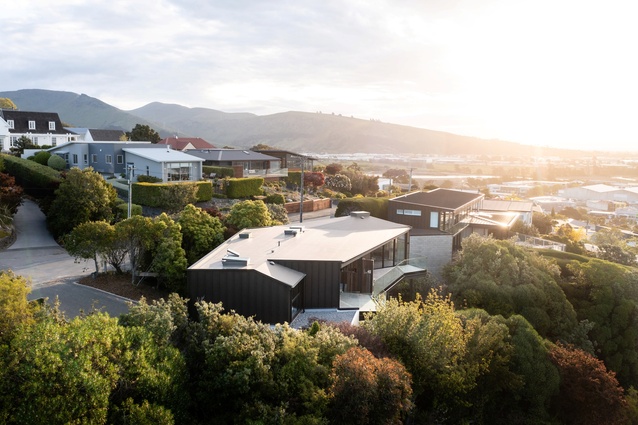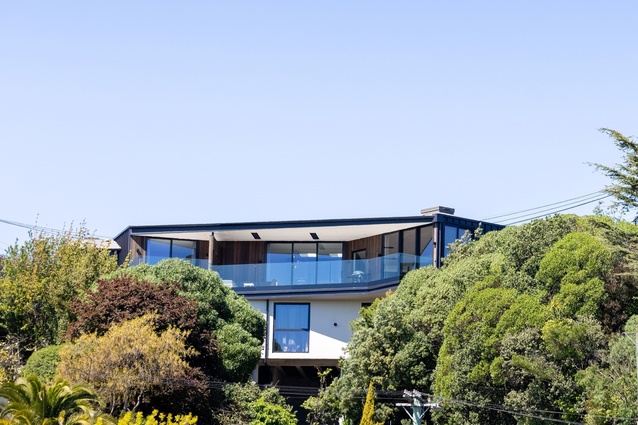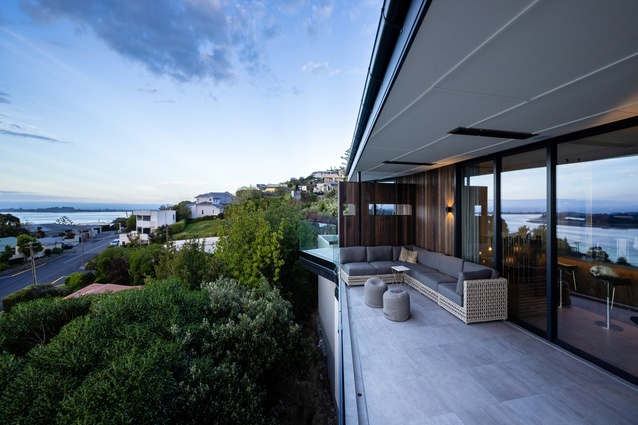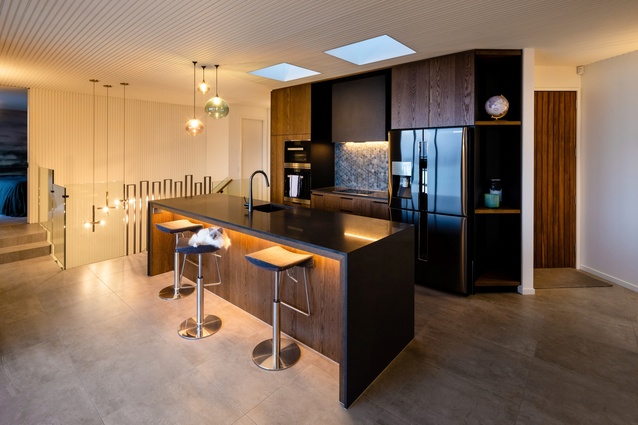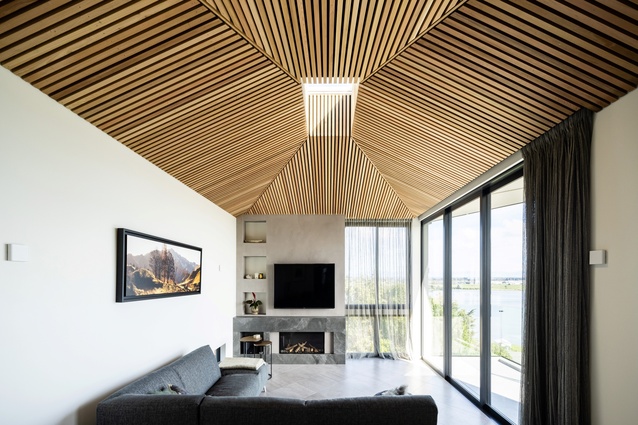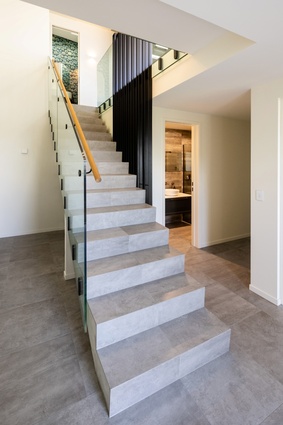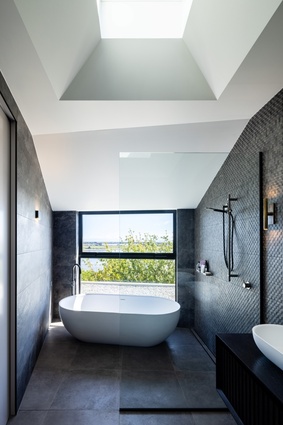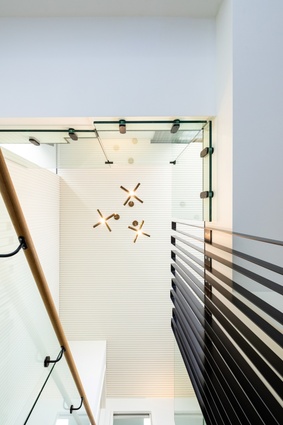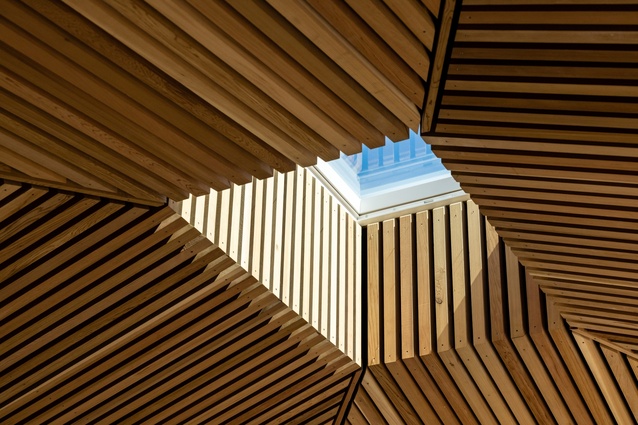Perched high on the Port Hills
This thoughtful collaboration between an Italian architect and his Cantabrian clients offers both a sense of enclosure and one of release, with a subtle nod to the architect’s Roman roots.
The highest elevation on the Port Hills, east of Christchurch, is Mount Pleasant Tauhinukorokio, standing at 499 metres. To its south is Lyttelton Harbour Whakaraupō and on its northern slopes is the Christchurch coastal suburb of the same name – Mount Pleasant.
The hill itself was once home to a Kāti Māmoe pā (some 300 years ago), and later to a trig station, and then farmland. Today, Mount Pleasant has an estimated population of almost 4000 people spread across its 247 hectares.
It is here that builder Nick Parsons and his wife Marie bought a steep 675m2 section in a high-wind zone on what can best be described as a ‘challenging’ site, excavated from a quarry. The house which had previously occupied the site had been demolished after the Christchurch earthquakes and Nick and Marie approached Max Capocaccia of MC Architecture Studio (and formerly Athfield Architects) to design them a home in response to the difficult terrain and climatic conditions.
“The site is at the top of a valley,” explains Capocaccia, “overlooking an estuary below and with the sea to the east. As it’s fairly exposed, we wanted to create a domestic environment that is essentially a cove, to offer a feeling of enclosure and provide cover from both the sun and the southerly winds.”
The resulting plan is a house made up of two wings, which reach inwards to the centre of the site and meet at the heart of the home.
On arrival from the south, the house appears embedded in the landscape, its exterior – part vertical timber shiplap, part tray metal wall cladding – almost acting as a protective shield that recedes into the surrounding dense foliage. An entry bridge resembling an estuary pier weaves through and above the existing mature bush, preserving the vegetation on the journey to the front door.
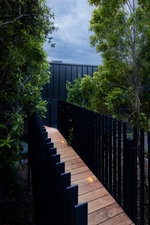
Once inside, in complete contrast to the private, windowless southern façade, the house opens to the northern sun and expansive views, providing a sense of enclosure and one of release at once.
“Like the Pantheon in Rome,” Capocaccia points out, himself a native of the Italian city where he completed a Masters in architecture, worked at his father’s practice and later established his own practice before moving to New Zealand in 2007. The Pantheon is renowned for the grandeur of its interior and, specifically, its immense rotunda topped with an oculus.
Capocaccia’s comparison, which he admits is, of course, “a very big stretch”, refers to the cedar batten-lined ceiling in the Parsons’ living and dining space, to the left of the front entrance. Here, the intention was to “open and soften the living area, creating a larger atmosphere out of what is essentially an intimate area.” The converging timber battens reach upwards to a central opening skylight, offering both light and cross-ventilation as well as sound absorption.
The 233m2 build took approximately a year, commencing in August 2020 shortly after the country came out of the first pandemic lockdown. Capocaccia says he and his clients worked right to the limit of maximum height to make the most of the views and much of the design of the three-bedroom home was a collaborative process. “The entire design process was productive discussion between myself, Nick and Marie over the emotions we wanted from the space and how we could achieve those.”
The light-filled internal stairwell features a concrete stair flanked by a sculptural steel and glass balustrade. Above hangs three Petrine brass pendants from Nightworks Studio. Other lighting includes Monmouth Glass Twist pendants above the dining table, and Dome pendants above the kitchen bench. Tiles in the kitchen and scullery are Hex XL Ecotones Denim Copper (248x286x5.3mm) and the master bedroom wallpaper continues the evocative mood with Emma Hayes’ Sediment Wallpaper – Forest. The master ensuite’s Venis Deco Mirage Dark wall tiles provide a tactile, woven effect and here Capocaccia has repeated the oculus skylight design from the living space, although without the timber battening.
Architect and builder have also worked hard to ensure this home performs well in terms of insulation values, with the external insulation of the thermal concrete-blockwork mass providing controlled thermal gain and the enhanced cross-ventilation during summer created by the chimney effect of carefully positioned low-lying south-facing windows and the opening skylight.

“We’re beyond happy with how our home has turned out,” says Marie. “It really helps when you know and trust your architects, either by reputation or, as in our case, personally. We had previously worked with Max and his team so when it came to designing our own home, we had a good understanding of how Max works and his talent for getting the best out of a tricky site while balancing the needs of the client.”
Marie says the team worked well together from the outset – Max and architectural graduate Caleb Skene spending a considerable amount of time on-site getting a feel for the surrounds and more time with Nick and Marie to understand how they wanted to live and what they wanted in terms of layout. “We didn’t need a large home, given that the majority of our family also lives in Christchurch, but we do love having family and friends over so we wanted living areas that were inviting,” she says. “We also wanted our master bedroom to be on the same level as our living so that was quite a lot on the upstairs level. The result was that the only tweaks we had to make to the original concept plan were minor.”
Marie and Nick said that in addition to having trust in your architect, they highly recommend taking a leap of faith when it comes to what may be perceived as the more “quirky” details proposed: “In our case, the timber battens running over the kitchen ceiling and down the stairwell, the plaster fire surround and the balustrade details along the top of the staircase,” they said. “These have turned out to be some of the things that we like best and we just can’t imagine them not being there because they add so much more depth and character. The result is that we are totally in love with our house and it really has felt like home from the start.”

